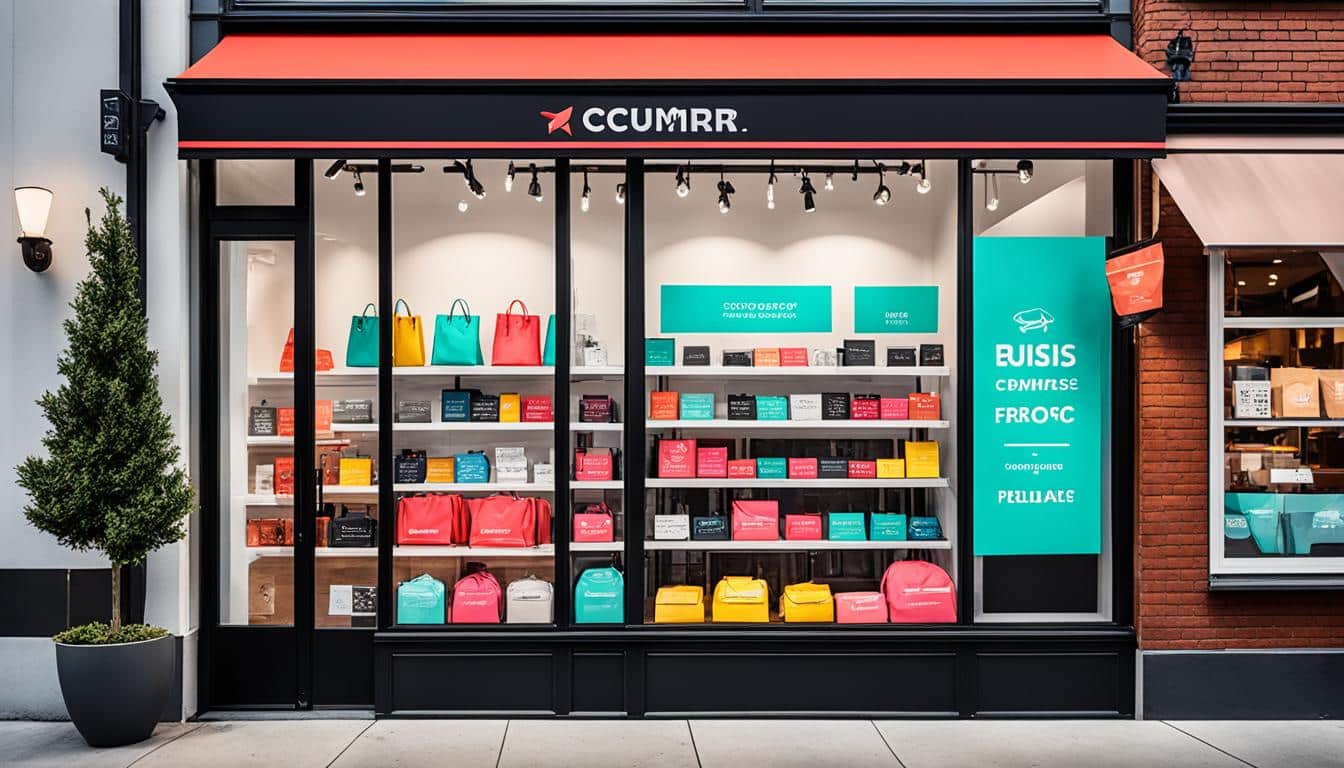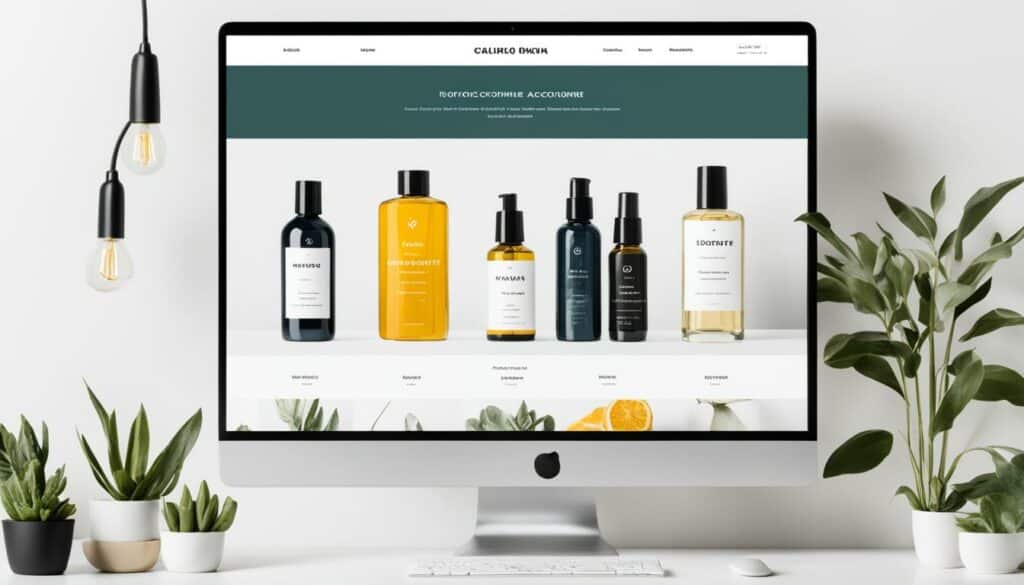Menu

Did you know 46% of U.S. customers would pay more for brands they trust? This shows how important branding is in e-commerce success. In today’s digital world, building a strong brand online is key, not just a plus.
Creating an online business these days offers many chances. From imagining what to sell to actually opening the store, there’s a lot to do. This includes looking for products that stand out, checking out the competition, making a solid business plan, choosing a special name, and creating a great-looking online shop. With the e-commerce market growing fast, focusing on your brand could lead to big wins in the future.
If you’re a traditional business wanting to go online, using Shopify can help. It makes moving online easier, giving you tools for your store and helping with building your brand. Strong brand building online can make more people notice you, increase how much they like you, and make them stay loyal to your brand.
E-commerce branding is key. It helps your online business stand out. This is done through unique style, engaging content, and a pleasant website look.
E-commerce branding means setting your online shop apart. It’s not just about how it looks. It’s about the whole online experience. Aim to make customers feel a connection. This boosts loyalty and brand memory.
The online market is growing fast. By 2024, we could see sales hit $6.3 trillion. To succeed in this busy space, a strong brand is crucial. It makes your products stand out and builds trust with customers.
Good branding includes clear messages that reflect your values. This gets your audience hooked. You’ll grow by getting close to people through your content and personal service. They’ll then see your brand as true and reliable.
Make sure your brand shows in all your online areas. Your website and content should echo your brand’s core. This consistency boosts customer trust. It also helps you shine among your e-commerce rivals.
Building a resonant e-commerce brand starts with knowing why you exist. It’s more than making money. It focuses on the problems you tackle and the change you want to make. A clear and inspiring purpose boosts your brand’s online impact and wins over your fans.

At the heart of a strong brand is understanding your “why.” Figuring out your brand’s reason for being is key to deep consumer connections. Nowadays, young buyers especially look for brands with a clear ethos. 62% of people, as shown in an Accenture study, prefer brands that deal with big issues.
Sharing your brand’s mission and values helps attract like-minded customers. 82% of buyers would rather support brands that share their values. This shared viewpoint lays the groundwork for loyal customers and brand supporters.
Izzy Wheels is a prime example of a purpose-driven brand. It was started by sisters Ailbhe and Izzy Keane. They make fun wheel covers for wheelchairs. Their work is about more than looks; it fights stereotypes and stands for freedom and self-expression for disabled people. By telling their story online, they’ve built a strong brand that speaks to their fans.
Izzy Wheels also stands out for its social and eco goals. It shares openly about its ethical and green efforts. Young buyers, from Gen Z to Gen Alpha, really value this transparency. This approach has helped Izzy Wheels grow and win over customers who support their values.
Izzy Wheels’ success highlights the power of a clear purpose. It shows how defining and sharing your brand’s stand can build loyalty and online influence. These are key in today’s competitive online world.
Making clear mission and vision statements is key in the online business world. They help bring everyone inside and outside the company together. Each talks about what the brand stands for and dreams of, connecting with people deeply.
A mission statement is like a compass for what your online brand does every day. It’s short (less than 100 words), and tells everyone your brand’s heart, what it sells, and who it sells to. A good mission boosts trust and support, like Amazon wanting to be super customer-friendly. Knowing your mission helps not just in deciding what to do but also in making customers trust you more.
The vision statement looks to the future, showing what your brand dreams to achieve. It should be bold but achievable. Tesla, for example, dreams of making sustainable energy the norm. Such big dreams not only inspire your team but also your customers, pointing everyone towards common goals and showing how to get there.
Love Her is a leader in matching their mission with their vision, especially known in the sports wear area. Their mission is all about providing top-notch sportswear that makes women feel powerful. It’s matched by a big vision: they dream of using amazing fitness clothes to help unleash the potential of women all over the world. This perfect pairing drives success now and in the future, showing their dedication and planning.
| Brand | Mission Statement | Vision Statement |
|---|---|---|
| Love Her | To deliver high-quality fitness wear that empowers women | Unlocking women’s potential worldwide through innovative and inspirational athletic clothing |
| Amazon | To be Earth’s most customer-centric company, Earth’s best employer, and Earth’s safest place to work | |
| Tesla | To accelerate the world’s transition to sustainable energy | |
| Apple | To bring the best user experience to customers through innovative hardware, software, and services |
Making sure your business lives by these mission and vision statements is crucial. They’re the North Star in your e-commerce world, guiding everything from daily work to big plans and ways to stay visible online. They help your brand look strong and unique, even among a crowded e-market.
Establishing core values is crucial for a brand’s identity. They also greatly impact its online image and how customers interact with it. These values show a company’s beliefs and behaviour. They help pull in people who share the same ideas, whether they are customers or workers.
Core values are like the heart and soul of a brand. They guide its dreams for the future and its day-to-day choices. Having real values boosts how much customers trust and stick with a brand. For example, almost half of buyers prefer brands that are big on sustainability. And over 40% like brands that support social issues. This shows how important values are for earning trust and loyalty.
Figuring out your brand’s core values is detailed work. It involves everyone on the team to make sure everyone’s on the same page. There are different types of values, like those for big dreams, basic rules, and happy accidents. The whole process from start to finish can last a few weeks to a few months. It makes sure you really know what your brand stands for. This clarity can make your online image stronger and make how you interact with customers clearer.
Indian Summer is a great example of using core values to set itself apart through green fashion and fair work. 77% of customers care about how their buys affect the planet. By truly caring about sustainable fashion, Indian Summer has won the hearts of many. It also makes them stand out in a busy market.

Brands like IKEA, Ben & Jerry’s, and Virgin Media have unique takes on core values. IKEA brings people together through its simple, budget-friendly items. Ben & Jerry’s fights for human rights and the planet. Virgin Media thrives on being curious and caring. Though very different, these values strengthen their bond with customers and enhance their online presence.
Creating a brand’s look is key to showing its character. Logos, colours, and designs make a brand stand out. They help people remember and recognise the brand.
Visuals are very important in marketing online. 92% of people say visuals affect what they buy. And 85% pick products based on their favourite colours. This shows how vital logos, colours, and designs are for brands.
A logo is a brand’s first impression. It shows its face to the world. Colours can make us feel things or remember certain brands. Everything from how words look to where the pictures are placed matters. They have to tell the brand’s story in a clear way.
Keeping the look of a brand the same is really important. A clear brand style guide helps with this. It ensures a brand looks the same wherever a customer sees it. Studies say most people form their first opinion of a brand based on how it looks. So, a detailed style guide is a big part of a brand’s strategy. It tells how to use logos, colours, and more. This makes sure all parts of the brand have one clear image.
Abeille Creations is a great example. Their design is both bright and bold, showing the founder’s love for art. This unique style not only makes the brand memorable. It also helps it stand out in a crowded market. E-commerce businesses with a strong look see their sales grow by 23%. This proves that a distinctive look is key for success online.
To sum up, a strong visual identity is fundamental for online marketing. Good logo design, using colours well, and a clear style guide boost how well a brand is known and liked.
Making your brand’s voice connect with your target audience is crucial. It helps build strong relationships and trust. By choosing the right tone, your marketing becomes more powerful and engaging on social media. We’ll look at how to craft a brand voice that stands out.
Your brand’s tone should match its identity and what your audience expects. Using great visuals and keeping messages consistent helps people remember and trust your brand. Knowing your customers well lets you speak to them in a way that creates deeper bonds.
Research shows nearly half of U.S. customers will spend more on brands they trust. This highlights just how important a strong tone is.
Brands that do well usually have clear voices that fit their identity and speak to their target audience. Take Nike, for example. It talks with an inspiring voice that especially appeals to athletes and those into fitness. Being active on social media helps them reach more people and interact with customers better.
Mailchimp is another good example. It uses a fun and friendly voice in emails, making readers feel connected and wanting more interaction.

| Brand | Voice Characteristics |
|---|---|
| Nike | Inspirational, Empowering, Motivational |
| Mailchimp | Humorous, Friendly, Approachable |
| Dove | Empathetic, Supportive, Inclusive |
Creating a good brand voice takes time and tweaking. It’s about always checking in to see if your tone fits your brand and is what your audience wants. This continual effort works wonders in keeping your customers happy and loyal.
Also, having a strong presence on social media is key for online selling. It helps you advertise to certain people and really get a conversation going.
For any e-commerce brand, knowing your target market is key. It helps in shaping your marketing plans. It also builds brand loyalty and boosts SEO. Let’s look at the basics you need to find your ideal customers.
The first step is to create detailed buyer personas. These are fictional profiles of different customers. You make them by looking at age, where people live, how much they earn, their education, and who they live with. You also consider their interests, values, and how they typically behave. This paints a clear picture of what they like and need.
When looking at market demographics, you use a mix of sources. The U.S. Census Bureau tracks current trends in the population. Sites like Quantcast show what over 100 million websites and mobile apps are doing. Big companies like McKinsey, Deloitte, Accenture, and EY also publish helpful research. They help you understand your customers better. Doing your own research through surveys, interviews, and discussions with your customers is also very useful.
According to the Zendesk Customer Experience Trends Report 2022, 68 percent of customers expect all experiences to be personalised.
This shows the need to make your online store meet your customers’ needs. Doing so will make them more loyal to your brand.
Let’s take VelociRAX as an example. They focus on adventure-loving cyclists. This group loves outdoor adventures and needs special gear. They also seek to be part of a community. By understanding them and creating targeted content and products, VelociRAX’s efforts pay off. They not only attract new customers but also keep them. This builds strong brand loyalty.
To sum up, getting to know your target market well is crucial. This means creating detailed buyer personas and looking at market data. Using both will help you plan smart e-commerce strategies.
Brand positioning is key in the world of online selling. It shows what makes your brand special. This makes it stick in people’s minds more easily, helping you stand out from others.
Doing a SWOT analysis is a big step in brand positioning. It’s about looking at your strengths, weaknesses, opportunities, and threats against others. By doing this, you can make smarter choices and plan better for the future. It’s all about knowing what you’re good at, fixing what isn’t working, and spotting chances to do more, while also being ready for challenges.
Finding and showing off what makes your brand unique is so important. It could be a new product, great service, good prices, or special features. These unique points make customers remember you. They choose to stay with you because you offer something that other brands don’t. The result is stronger branding online.

Agavus is a great example of using USPs well. They are famous for their unique, handmade watches. These watches tell a story of culture and skill, making them stand out in a busy market. By telling a strong story, Agavus becomes memorable and liked. Their approach shows how important it is to be different in online brand building.
In conclusion, brand positioning is vital. By doing a proper SWOT analysis, finding your USPs, and looking at success stories like Agavus, you can build a strong and unique online brand. This is what helps you shine in the tough online market.
Keeping a steady customer experience helps build trust and a good brand name. By making sure everything looks and feels the same, from website design to how you talk to clients, people connect more. They become more loyal to the brand.
In business, being reliable makes customers trust you. Research says 95% of buyers link good service to sticking with a brand. With a consistent strategy, companies create a smooth experience. This leads to more sales and fewer people leaving items in their shopping carts.
When customer questions get fast and similar answers, using tools like live chat, they are happier. Clear and consistent messages help form a strong brand identity. This lets people know what to expect, which increases their trust.
Target is a great example of this. It lives up to “Expect More. Pay Less.” and that keeps customers happy. Having steady prices, keeping people updated, and talking to them often makes Target stand out. It shows the value in their eyes, making them more loyal and involved.
By working to improve how customers feel, a business can earn 4-8% more in sales. So, staying steady in all online talks is key for market success. It’s part of doing a good job in online marketing strategy.
In the end, a great, trustworthy customer experience means more than just making sales. It means people spend more each time they buy and they come back. This makes it a big part of a successful online marketing strategy.
Good SEO is key for online success, making sure your brand is seen and brings in people naturally. By working on how your website looks and the contents it has, you can make a big difference in how well your brand is known online. We will look at what makes SEO important for online shops and how it makes your brand stronger.
SEO improves your online stuff to show up more in searches. Since half of web visits come from searches, knowing the SEO ABCs is a must for online sellers. Using detailed keywords helps you speak to the right people, boosting your contents’ power. Also, focusing on specific groups through clever keyword choices and being active on social media can make your brand more familiar.
Boosting your SEO game needs several steps:

Many tools are there to ace your SEO:
Mastering these SEO tactics can pull you up in searches, bring more visitors, and grow a brand that people instantly recognise.
Social media is key for many businesses now. It has over 4.2 billion users. This makes it a great place for brands to connect with customers and show off their brand.
Being active and interesting on social media is important. Platforms like Facebook and Twitter let brands talk directly to customers. This builds trust and loyalty.
It’s vital to post regularly and reply to comments. Keeping a clear brand voice is also key. This builds recognition and keeps followers interested.
Good marketing content makes people share it. Mix promotional stuff with educational and community posts. On Instagram and Pinterest, use great photos and videos. For LinkedIn, focus on business insights and communication.
Looking at successful campaigns can teach us a lot. Nike’s “Just Do It” campaign is a great example. It used inspiring stories to deeply connect with people. This boosted both interest and sales.
Studying social media analytics helps businesses improve. This means aiming messages more at certain groups. It makes social media a crucial part of digital branding.
In e-commerce brand building, winning over customers’ hearts is key. Repeat customers spend more than new ones. This makes the shift from one-time buyer to long-term friend a big win. For most companies, 65% of revenue comes from these repeat clients. Talking to them one-on-one, offering loyalty rewards, and top-notch service boosts their return and makes them feel valued.
More than 80% of online buyers care most about the product info. They trust it even more than the brand itself. Reading customer reviews is crucial, too. A review’s positive impact often means people are willing to pay extra. To keep up, brands should be loud and clear on social media, making sure every customer’s voice is heard.
SEO can help direct a significant portion, 32%, of new visitors to your site. Being up to date on what products are available stops missed sales. Social media sites like Facebook, Instagram, and Twitter are golden for chatting directly with customers. This personal touch can make all the difference, turning one-time shoppers into loyal supporters. In the end, it’s these supporters that give companies the edge, making it cheaper and easier to keep them happy than to always find someone new.
E-commerce branding gives your online shop a unique look and feel. It connects with customers on an emotional level. This trust and emotional bond is created through logos, design, and the stories you tell.
Branding stands your business out and keeps customers coming back. It’s more than just a logo. It’s about building a lasting relationship with your clients. A strong brand helps your company grow and last longer online.
Think about the problems your business solves and the change it wants to make. This should touch your customers’ hearts and minds. For example, Izzy Wheels shows how focusing on individuality can make a big difference.
Your mission tells people what you do now. Your vision shows them where you want to go. Together, they guide your business and let people know what you stand for. Love Her, for instance, wants to empower women with quality gym wear.
Core values show what your brand believes in. They attract those who share those beliefs. For example, Indian Summer’s green commitment helps it connect with eco-conscious customers.
To develop your look, think about your brand’s personality. Use logos and colours that represent this. This helps customers recognise you, like Abeille Creations’ distinct and colourful style.
Your brand voice is how you talk to your customers. It should match your brand’s feelings and values. Finding the right tone helps keep your customers happy and coming back for more.
To find your market, create detailed buyer profiles based on research. This helps in targeting your marketing and product development. VelociRAX, for example, knows just what adventure cyclists are looking for.
To stand out, understand your strengths and what makes you different. Using your strengths to attract customers is key. Agavus, for example, highlights their unique watches to draw in interested shoppers.
Be consistent in everything from your website to how you answer emails. This builds trust and keeps people coming back. Target, for example, prides itself on delivering a dependable shopping experience every time.
SEO in e-commerce is about making your site Google-friendly. This means good structure, content, and keywords. Using tools like Shopify’s checklist and analysing your strategy regularly can help you rank higher, get more visitors and boost your brand.
Social media is great for connecting with customers. Share posts that are fun, useful, or interesting. This gets them talking and caring more about your brand.
Make customers feel special with custom messages and bonuses. Listening to feedback and consistently adding value keeps them coming back. This wins you fans who tell their friends about your amazing products or services.